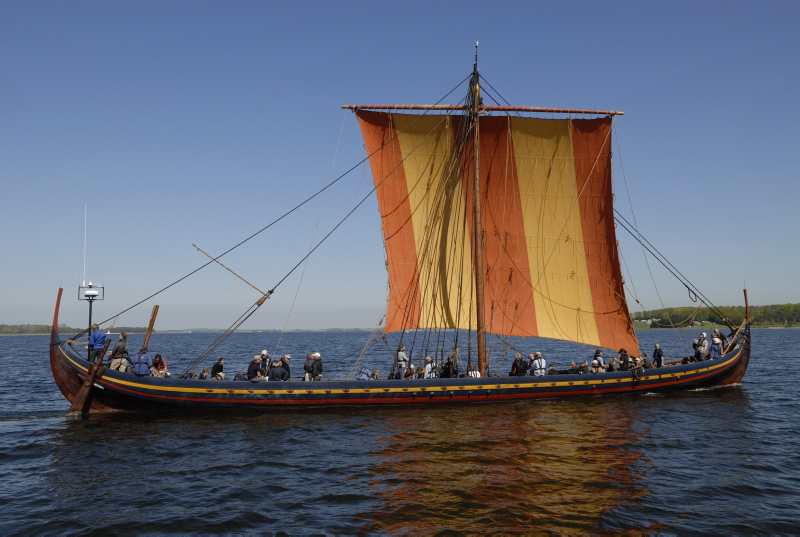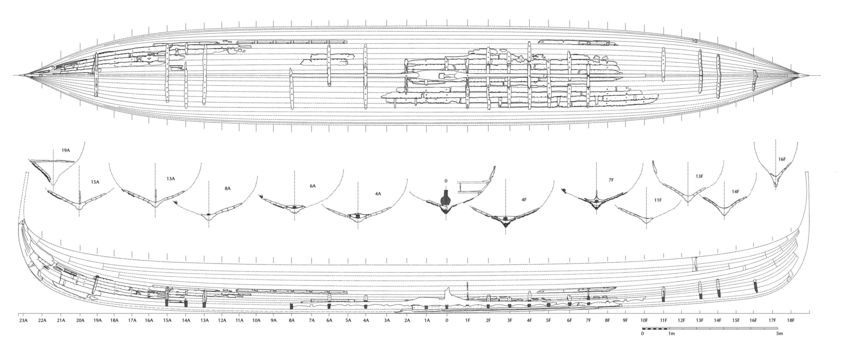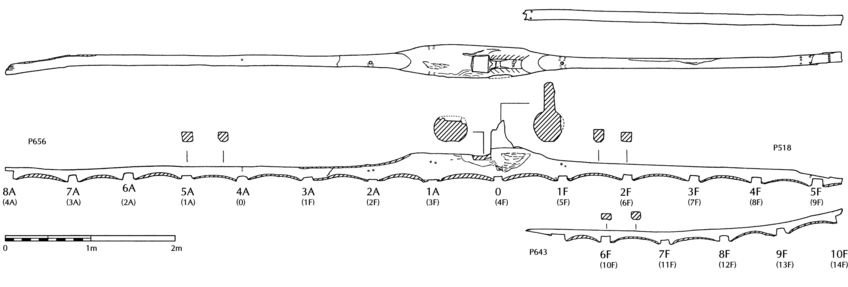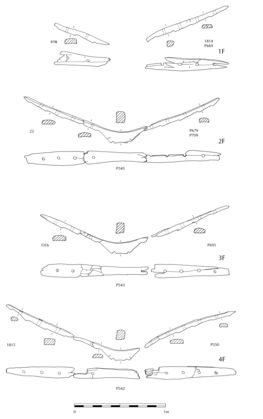Skuldelev 2
Skuldelev 2 was found in 1957 during the first underwater archaeological investigations by divers in Peberrenden, Roskilde Fjord. It was excavated together with the other Skuldelev ships in 1962. In the first instance the size of the ship surprised the archaeologists and it was presumed to represent the remains of two vessels. It was first during the subsequent analyses that it became clear that there was only one ship but of previously unseen dimensions.
Skuldelev 2 has been reconstructed to an original length of 29.28 m, a width of 3.76 m and a height midships of 1.77 m. As a consequence, the vessel is more than nine times as long as it is wide, and also rather broader than the slightly longer warship from Hedeby Harbour. The number of oars is, however, the same – 60 in total. This is possible because the distance between the ribs, and therefore between the oarsmen's thwarts, is even shorter than in the Hedeby ship – only about 70 cm.
By virtue of dendrochronological analysis of the wood in Skuldelev 2, both its date and place of construction are known. The tree from which the ship’s keelson was made was felled in May or June of AD 1042. The trees used for the planks, felled at the same time, grew in the vicinity of the town of Dublin and Waterford in southeastern Ireland. Both of these towns were founded and inhabited by Vikings, whereas the rural population at that time was Irish. It is therefore reasonable to assume that the shipbuilders who constructed Skuldelev 2 are to be found among the populations of these two towns – perhaps most probably Dublin, which even then was the most important town in Ireland.
Only around 25% of the original ship has survived the rather more than 900 years on the seabed, but fortunately the remains are distributed such that most aspects of the ship are well illuminated. The surviving stern comprises three parts, which together form a so-called stepped stern (see Skuldelev 5). As the ship has a greater number of strakes than can be attached to the sides of the stem and stern, short wide pieces of plank have been inserted which gather together several planks into one before they are attached to the stem and stern.
Another remarkable element is the keelson, which lies along the bottom of the ship. This is made from two pieces of timber and has a total length of 14.1 m long. It comprises a central robust section into which the step of the mast has been cut, and two long "arms" which extend out towards the stem and stern, respectively. On the lower surface of the keelson there are notches for the floor timbers, which the keelson has been slotted down over. Further to this, the keelson has been held in place by a series of small knees which were located on the sides and partially in over the keelson and which secured it to the floor timbers. Finally, a thick branch just behind the step of the mast has been shaped to form a support which extends up to the mast beam and prevent the keelson from capsizing.
One of the features, which make the keelson of great interest, is the way in which its two parts are joined together. It is the "arm" towards the stern, which has been extended with an extra piece of wood more than 4 m in length. The joint between the two pieces of wood is a so-called hooked scarf. This joint is only rarely seen in Viking shipbuilding and its special property is that it can withstand tension. If it is fitted with a so-called breast – as is the case with Skuldelev 2 – i.e. with a vertical surface where the two pieces meet, it can also withstand compression. Tension and compression arise in the keelson when the ship sails through large waves and alternately the midship and the stem and stern are not borne by the water, because they are in the valley between waves. If the ship is too slightly built, it flexes too much under these conditions and can break up. The hooked scarf shows us that the keelson had other functions than just bearing the weight of the mast and that the Viking shipbuilders were very well aware of the special problems associated with building very long, narrow ships – and had solutions to these problems.
One of the few places where the longship from Ireland differs from corresponding ships built in Scandinavia, is in the form of its ribs. The floor timbers, the term for the lower timber in the ribs, are unusually shallow and broad. The reason for this could be that the ship was built for the Irish Sea, waters which make great demands on the flexibility of the hull. In any case, it is interesting that the Scandinavians in Dublin in AD 1042 – which at that time had made strong contacts with the surrounding population – still built ships in a characteristically Scandinavian way.
Danish text: Jan Bill
Translation: Gillian Fellows-Jensen
Archaeological findings of longships
Learn more about the longships we know today. Some were found in burial mounds, others in the Viking's harbours and others were recycled by the Vikings as part of defense systems of their main towns.
Below you can find links to read more about the longships.
» Ladby - the ship in the grave
» The longship from Haithabu Harbour



